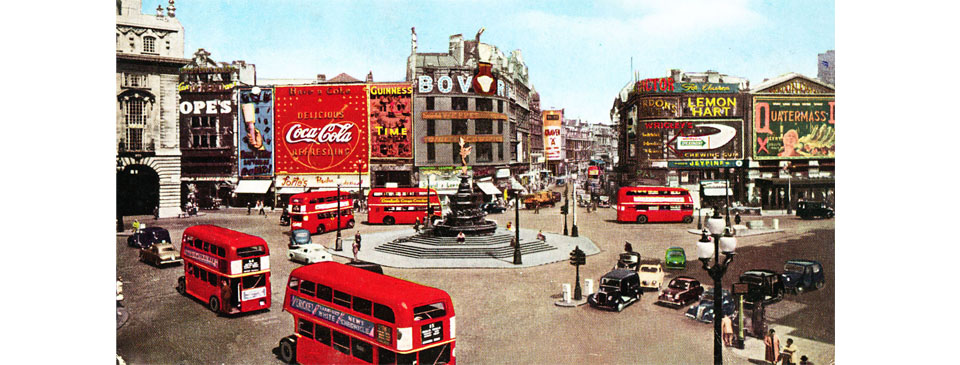In brief – Late-20th century London

Traffic flows around the Shaftesbury Memorial fountain at Piccadilly Circus in about 1955. The Bovril and Guinness advertisements had been in place for several decades when they were joined by Coca Cola shortly before this photo was taken. The film Quatermass Experiment is showing at the London Pavilion cinema.
After the war London’s many theatres found it difficult to compete with TV and cinema and a number were converted to other uses such as bingo or bowling, or simply demolished. A National Theatre Company was formed, initially operating from the Old Vic theatre. The South Bank grew into London’s largest arts complex, with the addition of the British Film Institute, Queen Elizabeth Hall, Hayward Gallery and a permanent home for the National Theatre. A new arts complex was incorporated into the Barbican development. The American filmmaker Sam Wanamaker conceived the idea of recreating the Elizabethan-era Globe theatre at Bankside. After many years of struggle it opened in 1996, a few months after his death. In the latter part of the century London’s theatres were once again beginning to attract larger audiences, in part due to a renewed popularity in musicals, an influx of tourists, and new types of drama.
In turn, the popularity of cinema waned from the 1960s and many were converted into multi-screen venues where multiple films could be shown to smaller audiences. As with theatres before them, some found new lives as music venues, non-denominational churches and even supermarkets.
A thriving live music scene blossomed. From the 1950s Soho cafés played an important part of the new music trends such as skiffle and rock and roll, creating new stars such as Cliff Richard, Lonnie Donegan, Tommy Steele and Billy Fury. The discothèque – a nightclub for dancing to recorded music played by a DJ – arrived in London from Paris in the early 1960s. New clubs opened around Oxford Street and Soho for live modern-jazz and blues, such as the Flamingo, the 100 Club and the Marquee, and later in places such as Camden. Large open-air concerts held in parks became a feature of London’s music scene each summer from the late 1960s onwards. London’s West Indian community formed a strand of the capital’s vibrant music scene.
New fashion and lifestyle trends evolved amongst London’s youth, such as Teddy Boys, mods, rockers, skinheads, hippies and punks, some of which originated in the US and others that were homegrown. New fashions emerged from young designers, sold by boutiques in Carnaby Street and King’s Road. With the rapid rise in popularity of the Beatles, and the fashions and pop-culture that followed in the mid-1960s, America’s Time magazine trumpeted the capital as “Swinging London”.
New types of suburban shopping centres were developed, the first of which in London were the Elephant & Castle and the Whitgift at Croydon. The first truly American-style shopping mall was opened at Brent Cross in 1976, at the junction of the North Circular Road and Hendon Way. It consisted of a large air-conditioned indoor shopping centre with two department stores and eighty shops. Together with its surrounding car parks it spread over eighty-two acres. In response Haringey Council created Wood Green Shopping City, which opened in 1981 and successfully maintained the popularity of the High Road. Another trend was the growth of retail parks in suburban areas, often created on what had previously been industrial land. At the centre of each was a large car park, surrounded by a number of large stores that often included a supermarket and an electric appliance store.
